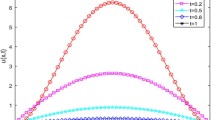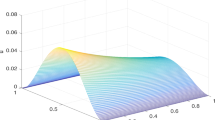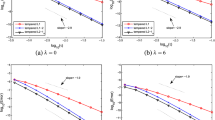Abstract
Tempered fractional diffusion equations (TFDEs) involving tempered fractional derivatives on the whole space were first introduced in Sabzikar et al. (J Comput Phys 293:14–28, 2015), but only the finite-difference approximation to a truncated problem on a finite interval was proposed therein. In this paper, we rigorously show the well-posedness of the models in Sabzikar et al. (2015), and tackle them directly in infinite domains by using generalized Laguerre functions (GLFs) as basis functions. We define a family of GLFs and derive some useful formulas of tempered fractional integrals/derivatives. Moreover, we establish the related GLF-approximation results. In addition, we provide ample numerical evidences to demonstrate the efficiency and “tempered” effect of the underlying solutions of TFDEs.







Similar content being viewed by others
References
Abramovitz, M., Stegun, I.A.: Handbook of Mathematical Functions. Dover, New York (1972)
Andrews, G.E., Askey, R., Roy, R.: Special Functions. Encyclopedia of Mathematics and its Applications, vol. 71. Cambridge University Press, Cambridge (1999)
Baeumer, B., Benson, D.A., Meerschaert, M.M., Wheatcraft, S.W.: Subordinated advection–dispersion equation for contaminant transport. Water Resour. Res. 37(6), 1543–1550 (2001)
Baeumer, B., Kovács, M., Meerschaert, M.M.: Fractional reproduction–dispersal equations and heavy tail dispersal kernels. Bull. Math. Biol. 69(7), 2281–2297 (2007)
Carr, P., Geman, H., Madan, D.B., Yor, M.: The fine structure of asset returns: an empirical investigation. J. Bus. 75(2), 305–333 (2002)
Chen, S., Shen, J., Wang, L.L.: Generalized Jacobi functions and their applications to fractional differential equations. Math. Comput. 85(300), 1603–1638 (2016)
Cushman, J.H., Ginn, T.R.: Fractional advection–dispersion equation: a classical mass balance with convolution-fickian flux. Water Resour. Res. 36(12), 3763–3766 (2000)
Deng, Z.Q., Bengtsson, L., Singh, V.P.: Parameter estimation for fractional dispersion model for rivers. Environ. Fluid Mech. 6(5), 451–475 (2006)
Diethelm, K.: The analysis of fractional differential equations. Lecture Notes in Math, vol. 2004. Springer, Berlin (2010)
Gorenflo, R., Mainardi, F., Scalas, E., Raberto, M.: Fractional calculus and continuous-time finance III: the diffusion limit. Math. Financ. 171–180 (2001)
Huang, C., Song, Q., Zhang, Z.: Spectral collocation method for substantial fractional differential equations. arXiv:1408.5997 [math.NA] (2014)
Jeon, J.H., Monne, H.M.S., Javanainen, M., Metzler, R.: Anomalous diffusion of phospholipids and cholesterols in a lipid bilayer and its origins. Phys. Rev. Lett. 109(18), 188103 (2012)
Li, C., Deng, W.H.: High order schemes for the tempered fractional diffusion equations. Adv. Comput. Math. 42(3), 543–572 (2016)
Magdziarz, M., Weron, A., Weron, K.: Fractional Fokker–Planck dynamics: stochastic representation and computer simulation. Phys. Rev. E 75(1), 016708 (2007)
Meerschaert, M.M., Zhang, Y., Baeumer, B.: Tempered anomalous diffusion in heterogeneous systems. Geophys. Res. Lett. 35, L17403 (2008). doi:10.1029/2008GL034899
Meerschaert, M.M., Scalas, E.: Coupled continuous time random walks in finance. J. Phys. A Stat. Mech. Appl. 370(1), 114–118 (2006)
Metzler, R., Klafter, J.: The random walk’s guide to anomalous diffusion: a fractional dynamics approach. Phys. Rep. 339(1), 1–77 (2000)
Metzler, R., Klafter, J.: The restaurant at the end of the random walk: recent developments in the description of anomalous transport by fractional dynamics. J. Phys. A Math. Gen. 37(31), R161 (2004)
Piryatinska, A., Saichev, A., Woyczynski, W.: Models of anomalous diffusion: the subdiffusive case. J. Phys. A Stat. Mech. A. 349(3), 375–420 (2005)
Podlubny, I.: Fractional Differential Equations: An Introduction to Fractional Derivatives, Fractional Differential Equations, to Methods of Their Solution and Some of Their Applications. Academic Press Inc., San Diego (1999)
Popov, G.Y.: Concentration of elastic stresses near punches, cuts, thin inclusions and supports. Nauka Mosc. 1, 982 (1982)
Sabzikar, F., Meerschaert, M.M., Chen, J.: Tempered fractional calculus. J. Comput. Phys. 293, 14–28 (2015)
Samko, S.G., Kilbas, A.A., Maričev, O.I.: Fractional Integrals and Derivatives. Gordon and Breach Science Publ., Philadelphia (1993)
Scalas, E.: Five years of continuous-time random walks in econophysics. In: The Complex Networks of Economic Interactions, pp. 3–16. Springer, Berlin (2006)
Shen, J., Tang, T., Wang, L.L.: Spectral Methods: Algorithms, Analysis and Applications. Series in Computational Mathematics, vol. 41. Springer, Berlin (2011)
Stein, E.M., Weiss, G.L.: Introduction to Fourier Analysis on Euclidean Spaces, vol. 1. Princeton University Press, Princeton (1971)
Szegö, G.: Orthogonal Polynomials, 4th edn. AMS Coll. Publ., (1975)
Zayernouri, M., Ainsworth, M., Karniadakis, G.E.: Tempered fractional Sturm–Liouville Eigen-problems. SIAM J. Sci. Comput. 37(4), A1777–A1800 (2015)
Zhang, C., Guo, B.Y.: Domain decomposition spectral method for mixed inhomogeneous boundary value problems of high order differential equations on unbounded domains. J. Sci. Comput. 53(2), 451–480 (2012)
Zhang, Y., Meerschaert, M.M.: Gaussian setting time for solute transport in fluvial systems. Water Resour. Res. 47, W08601 (2011). doi:10.1029/2010WR010102
Author information
Authors and Affiliations
Corresponding author
Additional information
This work is supported in part by NSFC grants 11371298, 11421110001, 91630204 and 51661135011. J.S. is partially supported by NSF grant DMS-1620262 and AFOSR grant FA9550-16-1-0102. L.W. is partially supported by Singapore MOE AcRF Tier 1 Grant (RG 15/12), and Singapore MOE AcRF Tier 2 Grant (MOE 2013-T2-1-095, ARC 44/13).
Appendices
Appendix A: Proof of Lemma 2.2
We first prove (2.42)–(2.43). Recall the fractional integral formula of hypergeometric functions see [2, P. 287]: for real \(b,\mu \ge 0,\)
Taking \(a=-n,~b=\alpha +1\) and using the hypergeometric representation (2.34) of the Laguerre polynomials, we obtain
which yields (2.42), i.e.,
Then, performing \({{}_{0}}\mathrm{D}_{x}^{\mu }\) on both sides and taking \(\alpha +\mu \rightarrow \alpha ,\) we derive from the relation (2.7) that for \(\alpha -\mu >-1,\)
This leads to (2.43).
We now turn to (2.44)–(2.45). According to [20, (6.146), P. 191 ] (or [21, (B-7.2), P. 307]), we have
Similarly, from the property: \({{}_{x}}\mathrm{D}_{\infty }^{\mu } {}_{x}\mathrm{I}_{\infty }^{\mu }\, u(x)=u(x),\) we derive
Finally, we prove (2.46). Noting that
(cf. [2, P. 191]), we derive from (2.34) and (A.2) that
Then acting the derivative \({{}_{}}\mathrm{D}_{}^{k}\) on (A.3) and using the identities (2.34), (A.2) again, we obtain
This ends the proof.
Appendix B: Derivation of (5.28) and the Entries of \({\mathbf {A}}\)
Derivation of (5.28)
-
for \(x\in {\mathbb {R}}^-\), \(0<s<1\),
$$\begin{aligned} \begin{aligned} {{}_{-\infty }}\mathrm{D}_{x}^{s,\lambda }\phi ^{*}(x)&={}_{-\infty }\mathrm{I}_{x}^{1-s,\lambda }{{}_{-\infty }}\mathrm{D}_{x}^{1,\lambda } \phi ^{*}(x)=\frac{e^{-\lambda x}}{\Gamma (1-s)}\int _{-\infty } ^x\frac{e^{\lambda \tau }(2\lambda )e^{\lambda \tau }}{(x-\tau )^s} \mathrm{d}\tau \\&\overset{t=x-\tau }{=}\frac{2\lambda e^{-\lambda x}}{\Gamma (1-s)}\int _0^{\infty }\frac{e^{2\lambda (x-t)}}{t^s} \mathrm{d}t =\frac{(2\lambda )^{s}e^{\lambda x}}{\Gamma (1-s)}\int _0^{\infty } e^{-2\lambda t}(2\lambda t)^{-s} \mathrm{d}(2\lambda t)\\&=(2\lambda )^{s}e^{\lambda x},\\ {{}_{-\infty }}\mathrm{D}_{x}^{s,\lambda }\phi ^{-}_{n_1}(x)&={}_{-\infty }\mathrm{I}_{x}^{1-s,\lambda } {{}_{-\infty }}\mathrm{D}_{x}^{1,\lambda }\phi ^-_{n_1}(x)\overset{(3.10)}{=}{}_{-\infty }\mathrm{I}_{x}^{1-s,\lambda }\{-({n_1}+1){\mathcal {L}}^{(0,\lambda )}_{{n_1}+1}{(-x)}\}\\&\overset{(2.44)}{=}-({n_1}+1)(2\lambda ) ^{s-1}L^{(s-1)}_{{n_1}+1}{(-2\lambda x)}e^{-\lambda x}\\ {{}_{-\infty }}\mathrm{D}_{x}^{s,\lambda }\phi ^{+}_{n_2}(x)&=0 \end{aligned} \end{aligned}$$(B.1) -
for \(x\in {\mathbb {R}}^+\), \(0<s<1\),
$$\begin{aligned} \begin{aligned} {{}_{-\infty }}\mathrm{D}_{x}^{s,\lambda }\phi ^{*}(x)&={}_{-\infty }\mathrm{I}_{x}^{1-s,\lambda } {{}_{-\infty }}\mathrm{D}_{x}^{1,\lambda }\phi ^{*}(x){=}\frac{e^{-\lambda x}}{\Gamma (1-s)}\int _{-\infty }^0\frac{2\lambda e^{2\lambda \tau }}{(x-\tau )^s} \mathrm{d}\tau \overset{\tau =x-t}{=}\frac{2\lambda e^{\lambda x}}{\Gamma (1-s)}\\&\quad \int _x^{\infty }\frac{ e^{-2\lambda t}}{t^s} \mathrm{d}t,\\ {{}_{-\infty }}\mathrm{D}_{x}^{s,\lambda }\phi ^{-}_{n_1}(x)&={}_{-\infty }\mathrm{I}_{x}^{1-s,\lambda } {{}_{-\infty }}\mathrm{D}_{x}^{1,\lambda }\phi ^{-}_{n_1}(x)\overset{(3.10)}{=} \frac{e^{-\lambda x}}{\Gamma (1-s)}\\&\int _{-\infty }^0\frac{-(n_1+1) L^{(0)}_{{n_1}+1}{(-2\lambda \tau )}e^{2\lambda \tau }}{(x-\tau )^s} \mathrm{d}\tau \\&\overset{\tau =x-t}{=}-e^{\lambda x}\frac{{n_1}+1}{\Gamma (1-s)} \int _x^{\infty }\frac{L^{(0)}_{{n_1}+1}{(2\lambda (t-x))}e^{-2\lambda t}}{t^s} \mathrm{d}t,\\ {{}_{-\infty }}\mathrm{D}_{x}^{s,\lambda }\phi ^{+}_{n_2}(x)&={}_{-\infty }\mathrm{I}_{x}^{1-s,\lambda }{{}_{-\infty }}\mathrm{D}_{x}^{1,\lambda }\phi ^{+}_{n_2}(x)\overset{(3.9)}{=}\frac{e^{-\lambda x}}{\Gamma (1-s)}\int _0^{x}\frac{({n_2}+1)L^{(0)}_{{n_2}}{(x)}}{(x-\tau )^s} \mathrm{d}\tau \\&=\frac{\Gamma (n_2+2)}{\Gamma (n_2+2-s)}x^{1-s}{\mathcal {L}}^{(1-s,\lambda )}_{{n_2}}{(x)}. \end{aligned} \end{aligned}$$(B.2)
The entries of matrix \({\mathbf {A}}\) with \(1<\mu =1+s<2\).
Since
then,
Similarly, we have
The entries of matrix \({\mathbf {A}}\) with \(0<\mu =s<1\).
Owing to
i.e.,
we obtain that
Similarly, we have
The above equations are enough to calculate out the matrix \({\mathbf {A}}\) due to some symmetric properties of the entries.
Rights and permissions
About this article
Cite this article
Chen, S., Shen, J. & Wang, LL. Laguerre Functions and Their Applications to Tempered Fractional Differential Equations on Infinite Intervals. J Sci Comput 74, 1286–1313 (2018). https://doi.org/10.1007/s10915-017-0495-7
Received:
Revised:
Accepted:
Published:
Issue Date:
DOI: https://doi.org/10.1007/s10915-017-0495-7
Keywords
- Tempered fractional differential equations
- Singularity
- Laguerre functions
- Generalized Laguerre functions
- Weighted Sobolev spaces
- Approximation results
- Spectral accuracy




